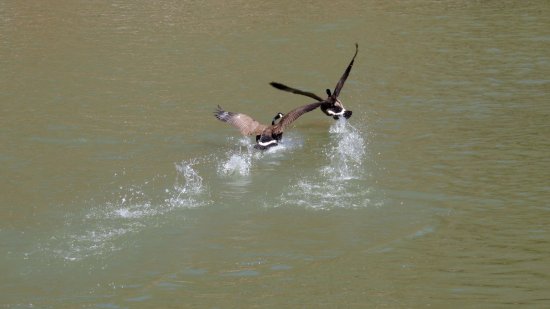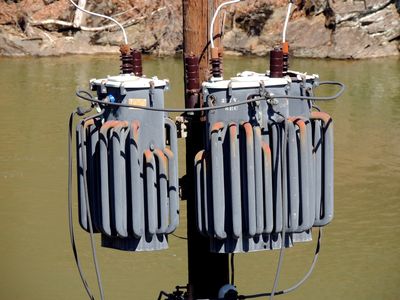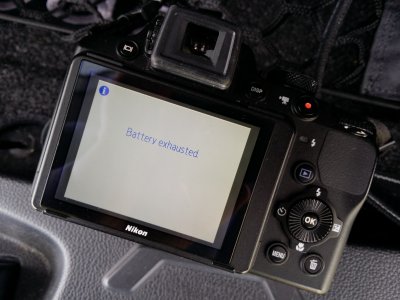Infrastructure pix with a borrowed camera…
6 minute read
April 10, 2014, 9:34 AM
I have had my current main camera, a Canon PowerShot SX10 IS, for approximately five years and two months as of this writing. The camera still works quite well, but is starting to get up there in age. For one thing, the fliparound screen on the back of it no longer works when the screen is flat against the camera while facing out. The electronic viewfinder comes on and the screen goes black when it’s in that position. Go figure. I’m also often finding myself “hitting the wall” with the camera as far as its limits go. Some of the ways I want to go with my photography, the camera can’t go there with me because it doesn’t go far enough. Also, if it gives you any concept of how much time has passed, I wrecked Big Mavica in a rainstorm after I had owned it for five years and four months.
All that said, I am looking to replace my main camera. In this case, however, there is no camera damage forcing my hand. My current camera works fine, though it is starting to show some signs of age. And even if the main camera was kaput, I have two other cameras plus a phone as backup. So this puts me in a good position, as there is no pressing need to replace equipment. I also do not feel that I am currently in a position to upgrade, so running on existing equipment works just fine for me.
However, this doesn’t mean that I’m not trying out other equipment when I can. I recently got an opportunity to borrow a friend’s Nikon Coolpix P510 and take it out for a photo shoot. The Nikon Coolpix P510 is a “prosumer” level camera similar to my Canon PowerShot SX10 IS, but is newer and takes photos in higher resolution (16 megapixel vs. 10). I did this mainly to see where the prosumer cameras had gone in the past few years, since I’ve been toying with the idea of getting another prosumer or finally going to a digital SLR.
So in playing with this borrowed camera, I went out to do some infrastructure photography. That brought me out to Brighton Dam, which impounds the Patuxent River to form Triadelphia Reservoir, which is about ten miles away from my house. I’d been to Brighton Dam twice before for photography, but I don’t think I’ve ever featured it on the website, though I have put some photos from both earlier visits on my Flickr, if you want to take a look. I chose Brighton Dam as my destination specifically because it was familiar. I didn’t want to plan a photo shoot to somewhere new when I was using a borrowed camera. I wanted a place where I already knew my way around so that I could focus on the equipment rather than the scenery, plus be able to compare pix. Thus the dam.
However, that doesn’t mean I skimped on things. With this shoot, I did more extensive photography of the area than I did both times before. The first time, I was with a friend and the visit was part of a larger itinerary, and then the second time, extreme cold and very low wind chills dictated that the visit would be short. This time, the weather was gorgeous, and I had all afternoon to play around with this camera.
And play I did. Take a look at some of the pix:
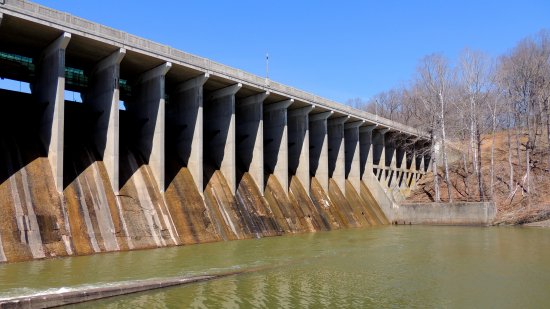
Brighton Dam. I am standing on the Montgomery County side. The land visible in the background is in Howard County.
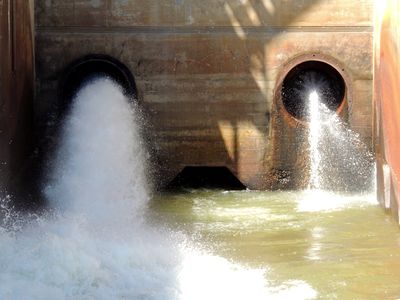
Pipes where water is discharged from the dam. The pipes, coupled with the unknown opening beneath, remind me of a face.

Water flowing over a wall intended to direct water towards the main channel of the Patuxent River.
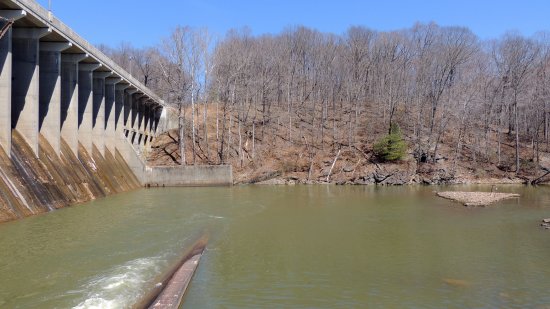
The Patuxent River, immediately downstream from the dam.
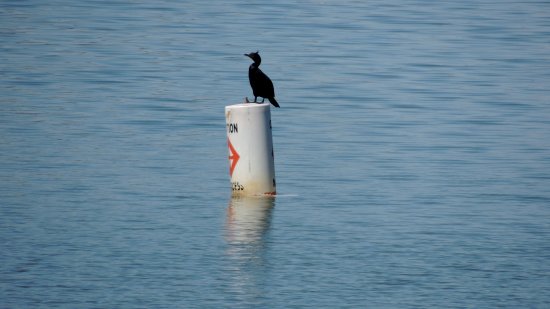
A bird stands on a buoy in Triadelphia Reservoir. Photographed from Brighton Dam Road, which runs across the top of the dam.
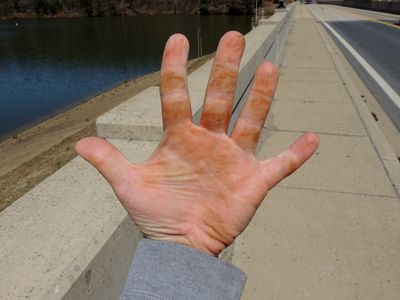
Rust on my hand, from clinging to a fence to get closer to the dam than I should have otherwise.
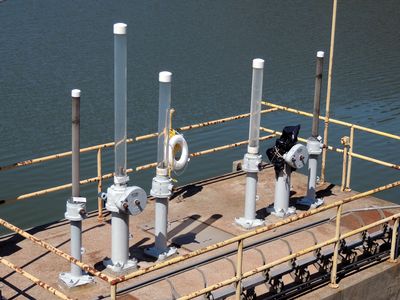
Various intake valves on a platform in Triadelphia Reservoir.
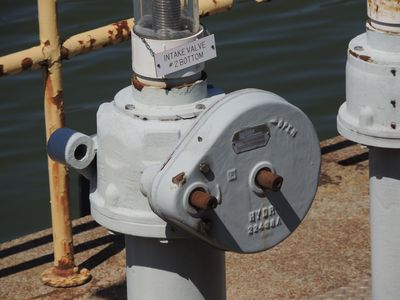
Close-up of intake valve #2 bottom.
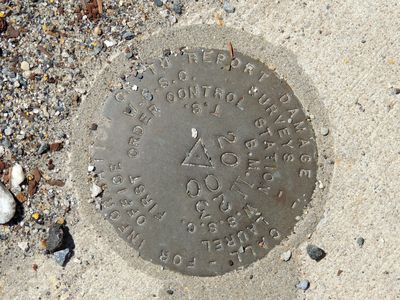
Benchmark on the west side of the dam.

Triadelphia Reservoir, viewed from atop the dam.

Geese downstream from the dam. I have no idea what the goose on the right is doing.
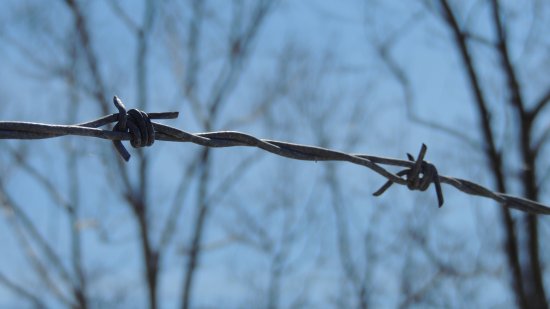
Barbed wire above a fence on the Howard County side along Brighton Dam Road.
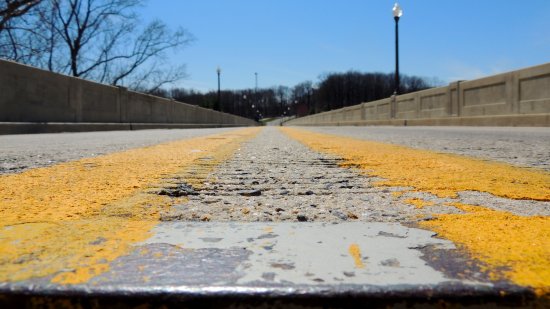
Low view down the middle of Brighton Dam Road, facing Montgomery County.
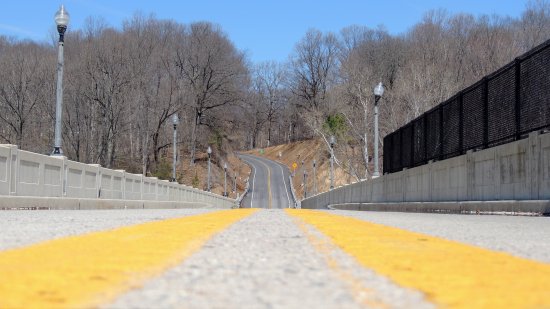
Low view down the middle of Brighton Dam Road, facing Howard County.
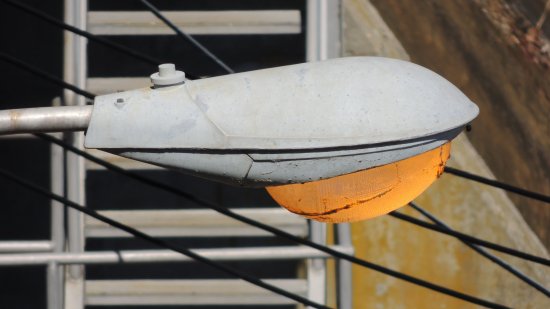
Cobra head light, photographed from an area between Brighton Dam Road and the perimeter fence around the site.
I took a total of 328 photos with the camera, and went until I ran out of battery power:
I then posted this picture to Instagram with the caption, “Something tells me that playtime is over.” Such is what happens when the camera takes an EN-EL5 battery rather than AA batteries. I didn’t get the charger for this battery (this was a somewhat spur-of-the-moment borrowing), nor did I have any spare batteries, and so when the battery ran out, that was it.
All in all, this was a good learning experience. First of all, this Nikon camera and my Canon camera are very similar to each other as far as layout of controls and screen menus go. The two cameras also operate very similarly, to the point that it felt natural to me with no learning curve. Image quality was similar as well. I did, however, find the way the screen flips out on this camera to be a little cumbersome, as it does not flip out or around like mine does. It will come out and angle up, but that’s about it. I also didn’t like it that the camera didn’t operate on AA batteries. I had my fill of non-AA battery cameras after Big Mavica, which took proprietary (and expensive) battery packs. However, other than an additional six megapixels of resolution and a more powerful zoom function, there were no additional features beyond what my Canon offers. In fact, it has less range than my Canon as far as aperture and shutter speeds go. Considering that this camera is a few years newer than my camera, this tells me that the prosumer lines have not evolved that much as far as features go over the last few years, and that was disappointing. Such is what happens, I suppose, but it also means that another prosumer camera is most likely not in my future, and that I need to start researching digital SLR cameras, because that’s where it’s looking like I want to go.
Web site: Pages for a modernization project at Brighton Dam, which show pictures taken inside the facility
Categories: Cameras, Photography











